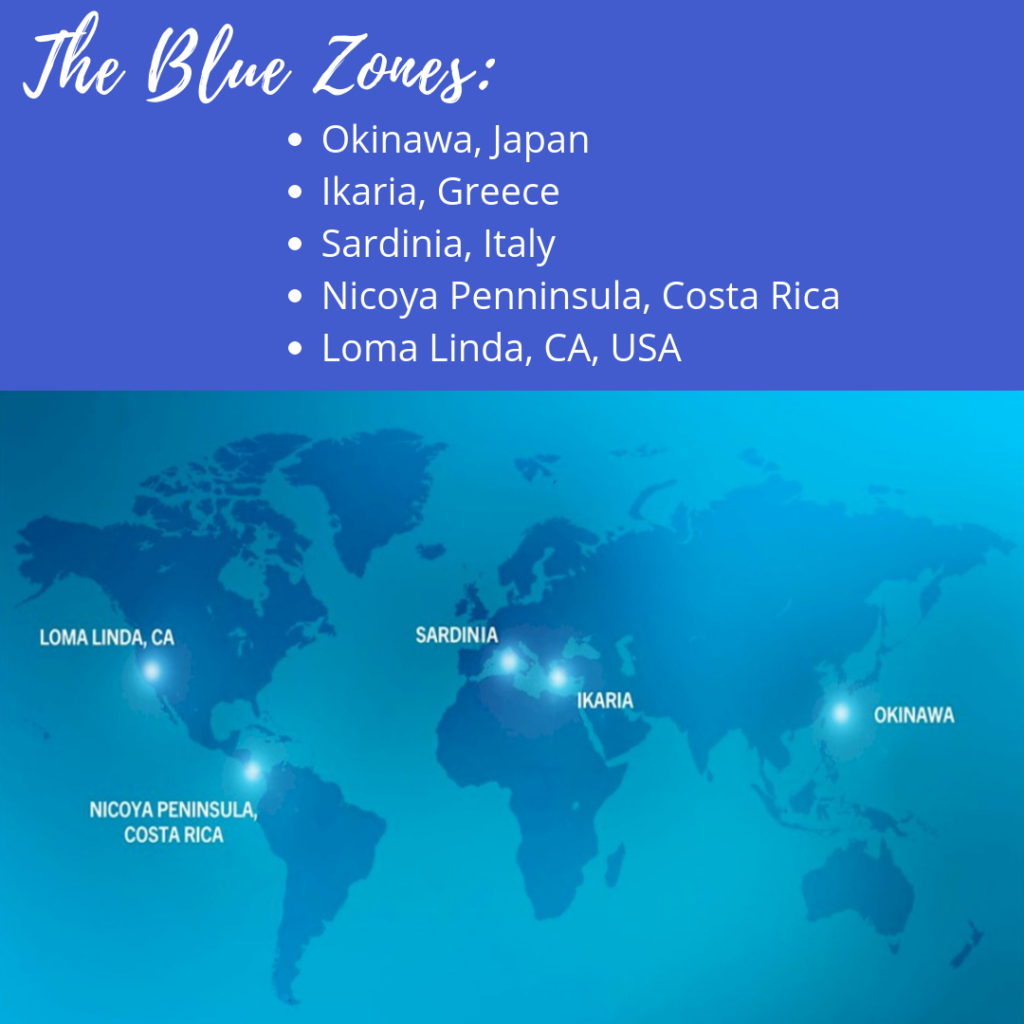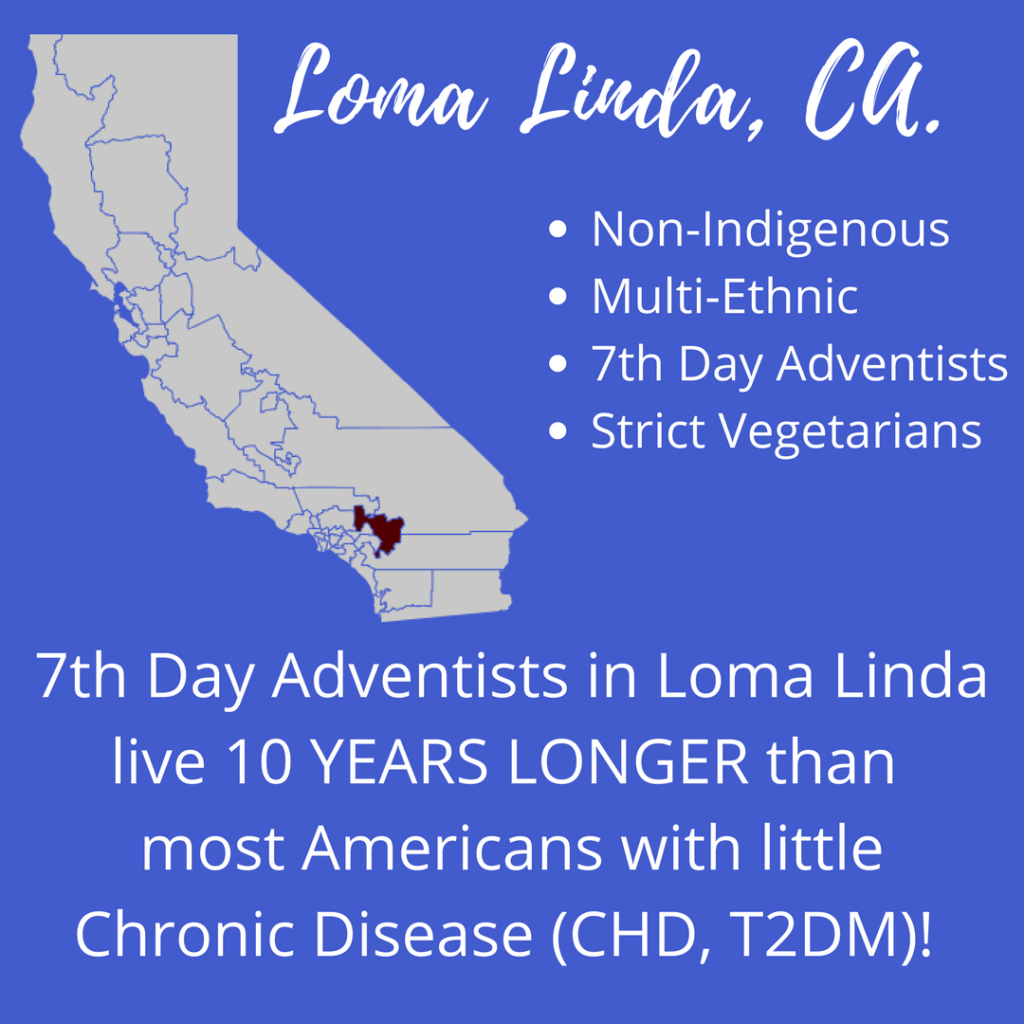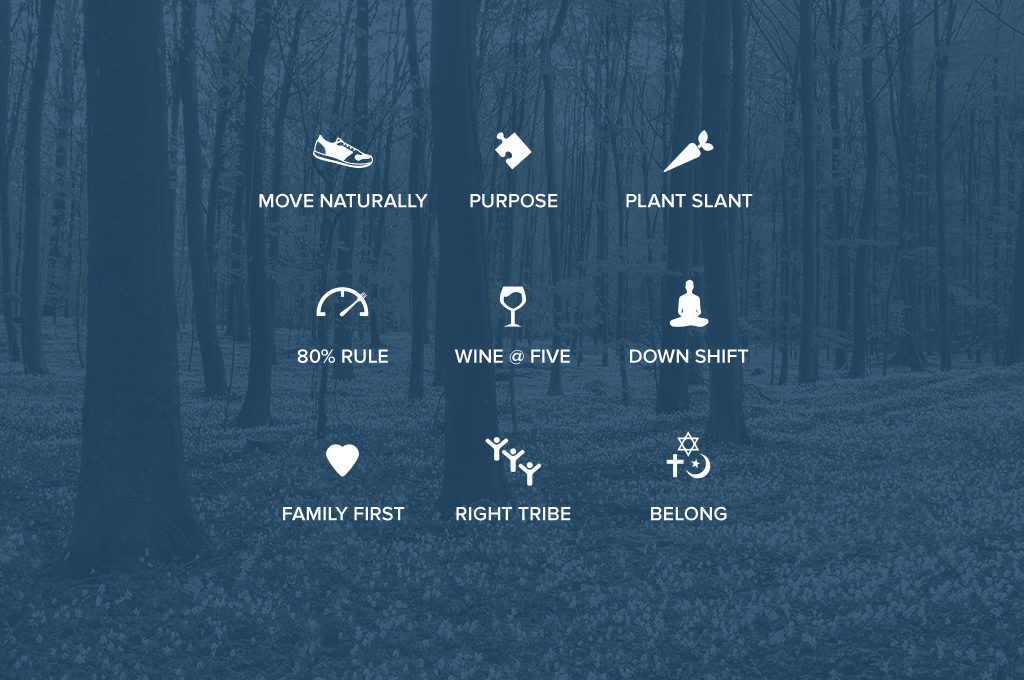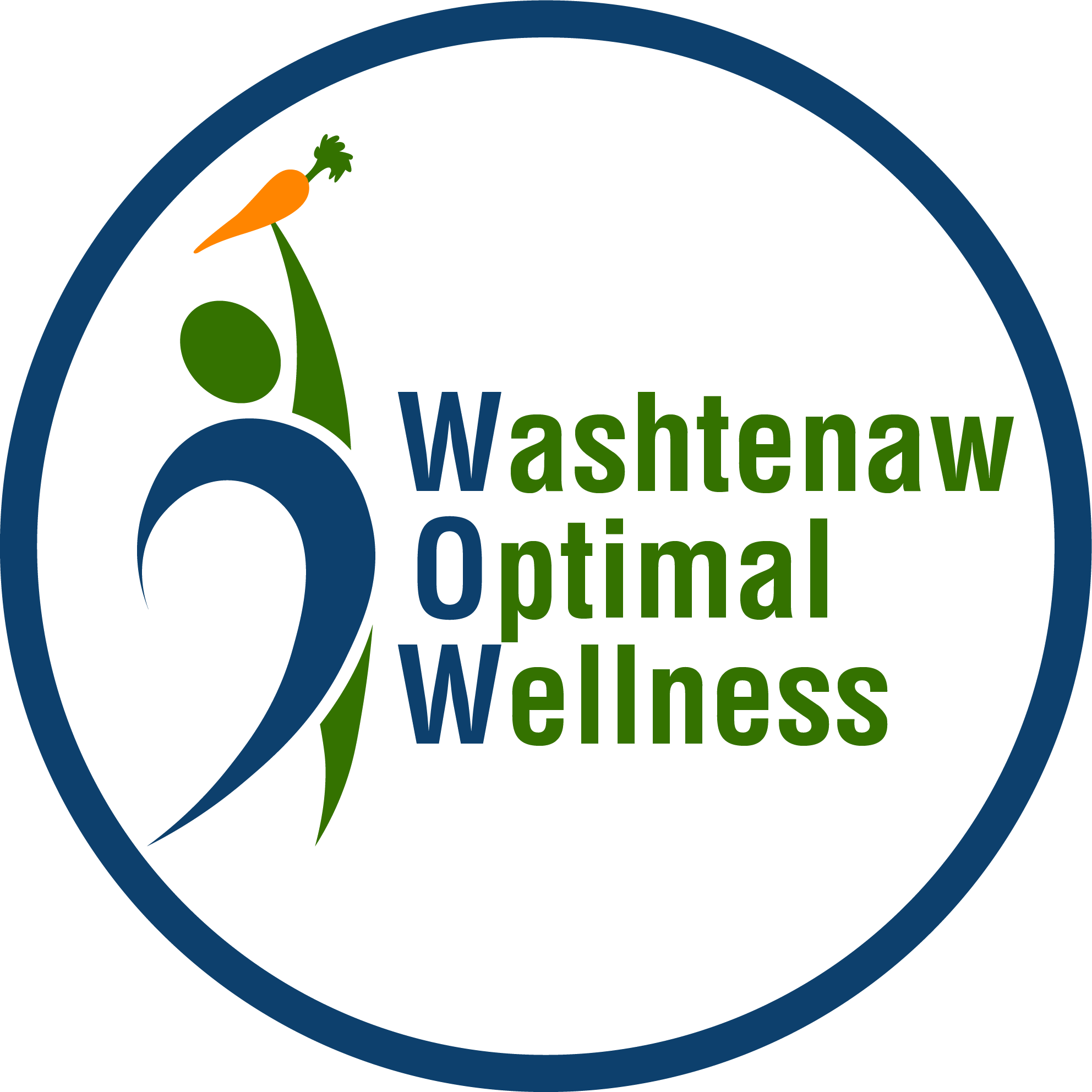What Is A ‘blue zone’?
A blue zone is characterized as an area of the world with a high concentration of centenarians, overall longevity, and little chronic diseases (lifestyle diseases like type 2 diabetes, and cardio vascular disease).
National Geographic and the National Institute of Health set out to locate these areas with verifiable birth data. The official Blue Zones are:
- Sardinia, Italy
- Okanawa, Japan
- Loma Linda, California, United States
- Ikaria, Greece
- Nicoya, Coast Rica

Loma Linda, California – The American Blue Zone
Perhaps the most interesting of the blue zone communities is Loma Linda, California. The citizens are non-indigenous and multi-ethnic, yet the average age for men is 89, and for women is 91. This is 10 year longer than the national average, and they are 10 times more likely to live to 100!
These facts show that longevity is not just genetics, it has more to do with lifestyle than anything.

The Power 9 ®
After completion of finding the ‘blue zones’, National Geographic Fellow – Mr. Dan Buettner, set out to create Blue Zones® Projects in other U.S. communities by implementing the Power 9 ® concepts which are as follows:
1. Move naturally
De-convenience your home, take the stairs, park farther away from the entrance and grow gardens. Have an errand not far away…walk! Walking is one of the best activities for longevity.
2. Know your purpose
Know why you wake up each day! This alone can add seven years to your life. Be able to articulate your values, passions, gifts and talents.
3. Down shift
Stress leads to chronic inflammation which is associated with every major age-related disease. Find your de-stressor: meditate, nap, pray, or enjoy happy hour with friends.
4. The 80% rule
Cut 20% of your calories with evidence based practices: eat a big breakfast, eat with your family, use 10 inch plates, and stop when you feel 80% full.
5. Plant slant
Eat a primarily plant-based diet that’s heavy on the beans, nuts and green plants.
6. Wine at 5
It appears that moderate drinkers outlive non-drinkers or heavy drinkers. Many centenarians drink 1 to 2 glasses of wine per day but not a drop more. Many centenarians and some blue zones communities abstain from alcohol consumption. ‘Wine at 5’ can be a wind down time with friends (a daily de-stressor and social time). OF NOTE: It is believed that the polyphenols (anti-oxidants) in wine may contribute to longevity, but other sources of polyphenols may be a healthier choice as alcohol is classified as a Group 1 Carcinogen (known to cause cancer) by the International Agency for Research on Cancer and World Health Organization. Alcohol consumption has been definitively linked to breast cancer in women, liver cancer, oral cancer, and colorectal cancer. (See: https://www.jpmph.org/m/journal/view.php?doi=10.3961/jpmph.14.052). The risks of alcohol consumption should be considered.
7. Family first
Living in a loving and thriving family can add six years to your ticker! Invest time in your kids, nurture a monogamous relationship and keep aging parents near by.
8. Belong
It doesn’t matter if you’re Christian, Buddhist, Muslim, Jewish or some other religion that meets as a community. Research shows that attending faith-based services four times per month will add 4-14 years of life expectancy.
9. Right tribe
Take stock in who your friends are and extend your social circle to include healthy-minded, supportive people.

https://communities.bluezonesproject.com/
Making The Healthy Choice The Easy Choice™
We spend 90 percent of our time in the same places, and that environment dictates how easy it is to make healthy choices, or how difficult. By using the Power 9®, the nine secrets of longevity, to improve where we live, work, learn, and play, we make it easier to get up and move, eat healthy, make new friends, find a reason for being—and live longer, better.
Other Blue Zones Projects:
Blue Zones® Project encourages changes to our community that lead to healthier options. By bringing residents, worksites, schools, restaurants, grocery stores, and government together, Blue Zones Project will inspire a community movement that has the power to improve the quality of life for everyone.
Keep Up To Date On Other Blue Zones® Projects
If you are interested in learning about what is happening with other Blue Zones® Projects, sign up for the Blue Zones® Project Bulletin HERE: https://info.bluezonesproject.com/bzp-bulletin
Albert Lea, Minnesota
The Blue Zones® projects are areas of the U.S. wherein the Blue Zone® lifestyle is being incorporated. One of the project sites is Albert Lea, Minnesota. The AARP/Blues Zones Vitality Project is sponsored by United Health Foundation and led by Dan Buettner, the author of ‘The Blue Zones’. The Vitality Project’s goal was to add 10,000 years to the lives of Albert Lea residents by encouraging them to make small changes in their daily lives. Albert Lea saw a whopping 49% decrease in insurance claims!
Here are some of the initiatives that they put in place:
- Walking Moai Program: Over 500 participants joined approximately 70 “walking moais,” which were groups of 4-10 walkers who agreed to meet once a week and walk to a set destination and back. They collectively walked over 75 million steps and approximately 32,000 miles. In addition, Walking Moai participants did over 2,200 hours of volunteer work. Both steps and volunteer hours were compiled for each group as part of an overall Walking Moai competition.
- Walking School Bus: The Walking School Bus Program found parents and volunteers to walk with groups of children to their respective elementary schools. A walking bus is said to encourage children to walk more, help build social networks, and assist in keeping kids safe on their way to school.
- Vitality Compass: The Vitality Compass is an online tool which is now available nationwide. It asks participants questions about their eating habits, sleeping habits, levels of stress, and amount of daily activity. At the end of the online survey, participants are given an age which is their approximate life expectancy. For the purposes of determining the efficacy of certain aspects of the Vitality Project participants were asked to take the Vitality Compass twice; once at the beginning of the program and again at the end. The average life expectancy for those who took the Vitality Compass at the beginning and at the end of the program increased by three years.
- Volunteering: Vitality Project organizers encouraged participants to volunteer in their community.
- Employers: Employers were encouraged to make their work environments more amenable to practices leading to good health. For example, some employers added healthy alternatives to vending machines.
- Grocery Stores: Vitality Project organizers encouraged grocery stores to feature those foods which are thought to engender better health and increased life expectancy.
- Neighborhood Picnics: To encourage community building and social networking, several neighborhood picnics were held and all people in a given neighborhood were invited to attend.
- Community Gardens: The City of Albert Lea in cooperation with the Vitality Project made space available for citizens of Albert Lea to plant vegetables and flowers.
- Purpose Workshops: Workshops addressing the importance of finding one’s sense of purpose were provided to Albert Leans for free. The workshops were led by Richard Leider, a nationally known executive coach who is also founder and chairman of The Inventure Group.
In addition to the these programs, the city of Albert Lea worked toward making their community more walkable and sustainable.
Source: https://en.wikipedia.org/wiki/AARP/Blue_Zones_Vitality_Project
Naples, Florida
Another great success story is Naples, Florida which is now ranking first on the Gallup-Sharecare Well-Being Index® Community Ranking for 2016, the Naples area leads the nation in well-being!
California Beach Communities
The California Beach Communities Blue Zones® Project saw childhood obesity decline by 50%!
Helping kids develop healthy habits affects lifelong well-being and healthcare costs. Other BZ Projects saw a 10-15% increase in kids walking and biking to school.
More Results
See more Blue Zones ® Project results here: https://www.bluezones.com/blue-zones-project-results/
Other US Communities
More Information Available at: https://www.bluezonesproject.com/
Brief Video About Blue Zones Projects:
Dan Buettner On The Today Show
On the TODAY show: National Geographic author Dan Buettner shares tips and tricks for increasing longevity that he learned while exploring blue zones, or communities around the world that have the highest percentage of people who live to age 100.
https://www.today.com/video/tips-for-living-a-longer-healthier-life-73134661699
